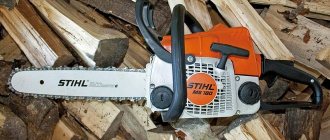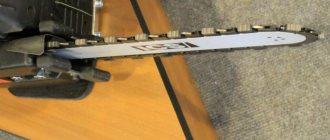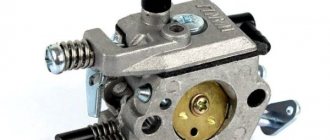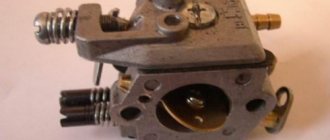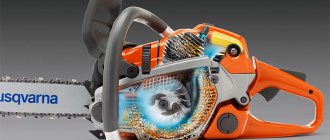A hand chainsaw can be a great tool for working with wood. However, not many people know that the first hours of operation of the unit require compliance with certain break-in rules. Running in a chainsaw is a process necessary for both new and overhauled tools. Beginners who have never had experience working with a chainsaw need to approach this process with all responsibility. It should be noted that even if an incompetent seller claims that the saw’s break-in procedure is optional, it is still recommended that you read the instructions that came with it and this article before the first start.
Running in a new chainsaw or the importance of this event
During the grinding of parts, working gaps are formed between the cylinder and the piston rings. Even at the break-in stage, compression in the cylinder increases, which has a positive effect on the operation of the internal combustion engine and the power of the tool. The procedure allows you to increase the service life of a two-stroke engine, and if you do not pay attention to this process, the engine may jam the first time you use the chainsaw.
In addition to reducing the service life of internal combustion engine parts in the absence of running-in, the engine will work significantly worse, and instead of the amount of horsepower declared by the manufacturer, the tool will produce 2 times less. Any new chainsaw needs running-in, regardless of who its manufacturer is. You also need to run in chainsaws that have undergone engine overhauls, but we’ll talk about that separately. Not only does the internal combustion engine of a new chainsaw need grinding in, but also the saw set - the chain and bar.
Many beginners wonder whether running in a chainsaw is necessary. And sometimes a simple answer is not enough for a person to understand how important it is to break in the tool. To understand the importance of break-in, you need to know what happens when you start the engine:
- After the chainsaw engine starts, the fuel-air mixture burns in the cylinder, causing the cylinder, piston and other structural parts to heat up.
- When heated, the parts expand, resulting in an increase in the coefficient of friction.
- The higher the friction coefficient, the more the parts heat up. If critical temperatures are reached, a piston melting effect will occur, which will immediately lead to jamming of the internal combustion engine.
- To eliminate this process, you need to run in the chainsaw. It is a procedure where the engine of the tool is operated without load or with short-term average loads.
There are different opinions among tool owners about how to properly break in a chainsaw. Some masters recommend carrying out the procedure exclusively by running the engine at idle, while others, on the contrary, believe that the tool should be allowed to work not only at idle, but also under moderate load. Having figured out the question of whether running in a tool is necessary, let’s move on to clarifying the features of the correct execution of the procedure.
Advantages of factory break-in
It should be noted that new saws from many leading manufacturers do not require running-in. The running-in of the piston group and working equipment using special technology is carried out directly during the control tests.
Reducing the time of this stage is facilitated by chrome plating the inner diameter of the cylinder and applying wear-resistant coatings to the working surfaces of loaded parts. However, recommendations for a gentle treatment during the first hours of operation of the instrument remain valid.
Is it necessary to load the chainsaw during break-in?
Some tool sellers recommend that after purchasing a chainsaw, buyers carry out the process of grinding in parts with complete elimination of the load. It even goes so far as to have owners remove the chain and bar and let the engine run at zero load. Is this approach to the procedure considered correct? This approach is not recommended for the following reasons:
- Not only the internal combustion engine parts need grinding, but also the saw set, or more precisely, the chains, tires and sprockets.
- Idling will not allow you to achieve the required load, so after the end of the process, when work is performed at high speeds, the motor may jam.
- The rotation of the chain when starting the engine of a new chainsaw provides the optimal load value, so the tool runs in not only more efficiently, but also faster. To complete the grinding as quickly as possible, the tool is gradually loaded by sawing wood of a small diameter.
- Idling the engine causes a reduced amount of mixture to enter the combustion chamber. Its insufficient volume prevents optimal lubrication of moving parts, thereby increasing their wear.
That is why, before you start running in the chainsaw, you need to install the bar and chain on the tool and ensure the correct tension. Next, you will need to fulfill some more important conditions:
- Prepare a benzine-oil mixture. Instructions for preparing the mixture for a chainsaw are described in detail here. However, when running in, it is important to maintain other proportions, as described in detail below.
- Fill the tank with chain oil, which lubricates the bar and chain. The chain can be placed in oil for several hours.
Interesting to know! The duration of grinding in chainsaw parts is measured not by the operating hours of the engine, but by the amount of fuel burned. To ensure effective running-in of the tool, it is necessary to burn at least 3-5 tanks of fuel. The maximum running-in duration lasts 6-8 burned tanks of fuel. The best option is to read the instructions, since each manufacturer indicates this information, which should be followed.
Carburetor adjustment
A full run-in of a new chainsaw involves properly setting up the fuel system. Standard factory carburetor adjustment is made on the basis of averaged data, therefore, depending on external factors, it needs to be adjusted.
A saw with an adjusted carburetor should quickly pick up speed, equally stable at operating mode and at idle speed. The proper quality of the air-fuel mixture is also indicated by the brown color of the spark plug insulator.
How to properly prepare a gasoline-oil mixture for a chainsaw during break-in
As has already been said, during the process of running in a chainsaw, grinding in of parts occurs. To increase the quality of grinding in parts, it is recommended to fill the tank with gasoline with an increased amount of oil than recommended by the manufacturer. Why is this necessary? During lapping, an increase in friction is observed, so the parts heat up more. To reduce the heating temperature, the friction coefficient should be reduced, which is possible by preparing gasoline with an increased amount of oil.
The gasoline used is AI-92, and you should not use fuel with a higher octane number, as this will only harm the instrument. The buyer must only be sure that the gasoline being poured is of really high quality and corresponds to the declared resistance to ignition under compression.
Oil for preparing the fuel mixture should be used only and exclusively two-stroke. How much oil should be added to 1 liter of gasoline during break-in? To do this, refer to the instructions supplied with the tool, where the manufacturer indicates the normalized value. As a rule, this indicator corresponds to a value of 1 in 50 or 1 in 40. Less common norms are 1 in 30 and 1 in 25, and often such values are presented for Chinese chainsaws. Now let's find out how to properly prepare the gasoline-oil mixture when running in a chainsaw? When grinding in instrument parts, you need to rely on the manufacturer’s recommended proportion value with an addition of 20% or 5-10 ml.
- If the manufacturer recommends diluting gasoline with oil in a ratio of 1 to 40, which corresponds to 1 liter per 25 ml. In this case, you need to add another 5-10 ml to 25 ml of oil. This proportion is appropriate only for the period of running in the tool, which allows reducing overheating of the CPG. However, there is no need to be zealous, since carbon deposits cannot be ruled out on the walls of the CPG.
- When running-in is carried out in winter, then at least 10 ml of oil is added to the norm, and if in summer, then it is enough to add 5 ml to the normal proportion. Increasing the proportion of gasoline and oil in winter must be done in order to prevent excessive viscosity of the lubricant at low temperatures, which will lead to poor quality lubrication of parts.
- It is recommended to use only 2T synthetic oils intended for internal combustion engines with an air cooling system. Synthetic oils are more expensive than mineral oils, but they help increase the service life of the CPG of your tool.
It is not recommended to store the finished mixture for more than 2 weeks if alcohol is present in the composition. If you are sure that gasoline is not diluted with alcohol, then the storage period increases to 2-3 months. Knowing how much oil needs to be added to gasoline when running in a chainsaw, you can safely prepare the mixture and begin the procedure.
Interesting to know! If you are running in chainsaws of the Druzhba or Ural brand, then when running in the engine you need to adhere to the proportion of 1 to 15, that is, you need to add 66 ml of oil per 1 liter. After grinding in the parts is completed, add 50 ml of oil per 1 liter of gasoline.
Features of fuel preparation
Each chainsaw differs from similar models in terms of design features and dosage of the fuel-oil working mixture, so even if you have the proper experience, it is recommended that you familiarize yourself with the contents of the attached operating instructions.
To prepare fuel, it is recommended to use fresh gasoline with an octane number of at least 90 and heat-resistant motor oil recommended by the manufacturer, in the dosage specified in the instructions.
The fuel mixture in an amount sufficient for one-time operation is prepared in a fireproof metal container, preferably with a sealed cap. In the absence of oils recommended by the manufacturer, replacement with a full-fledged analogue of the JASOFB or ISOEGB category is possible.
Gasoline with an oil component should not be stored for more than 2 months. The performance properties of an overexposed gasoline-oil mixture deteriorate significantly over time.
Fill the tank with chain oil and check the serviceability of the oil pump
The oil tank must only be filled with special chain lubricant. After filling the tool with oil, you can start the engine and make sure that the oil pump is working properly. This is quite simple to do, for which you need to place a blank sheet of paper on the end side of the tire. After starting the engine, and with increasing speed, the chain will rotate, and oily spots should appear on the paper, indicating a normal supply of chain oil to the tool tire.
Characteristics and advantages of the Stihl MS-250 chainsaw
Let's get acquainted with the advantages of the German-assembled Stihl chainsaw:
- Reliable, durable tool.
- Original spare parts are interchangeable (with other modifications).
- High build quality.
- Possibility to choose the right tire size.
- Automatic and economical lubricant supply.
- Possibility to select the necessary chain - Oilomatic or Picco with pobeditovy tips.
- Unpretentiousness in care and operation.
- High safety of all components and mechanisms.
- High power and torque.
- Easy launch.
- Anti-vibration protection.
- The presence of a compensator in the carburetor.
- Easy access to the air intake.
- Reusable air filter.
- Simplified single-lever control.
- Protection from atmospheric precipitation.
- The chainsaw is easy to repair.
- Among the shortcomings, there is only one - the high price of the saw itself and its spare parts.
The procedure for breaking in a new chainsaw - setting up the tool and starting the engine
In order for the chainsaw break-in procedure to be as efficient as possible, you will need to purchase a tachometer. This device is needed to measure the number of crankshaft revolutions when the internal combustion engine is running. This device will be needed not only for adjusting the carburetor of the tool before running it in, but also during operation of the chainsaw. The principle of adjusting the carburetor before running in the tool is that it is necessary to reduce the number of maximum revolutions by 600-700 rpm. The maximum speed reaches 12.5 thousand rpm, but achieving them during break-in is extremely dangerous. In addition, a decrease in maximum speed helps to enrich the mixture with fuel, which has a positive effect on the grinding in of parts.
Interesting to know! The procedure for adjusting the carburetor before running in the chainsaw is not at all mandatory, since such actions are performed at the factory after assembling the tool. For 3-4 hours, chainsaws are tested, for which high speeds are reduced by moving screws H and L. If the technical documentation from the manufacturer does not indicate the need to adjust the carburetor, then you can carry out such manipulations only at your own discretion. In any case, if the carburetor is properly configured, this will only be an additional advantage.
The tachometer is connected to the tool, and we proceed to adjust the carburetor, enriching the mixture. For this purpose there is a special screw on the carburetor H. It allows you to increase or decrease high speeds. By rotating screw H, it is necessary to achieve a tachometer reading 600-700 rpm lower than the maximum value, that is, reduce it to 11900-11800 rpm.
By reducing the maximum speed, it is possible to obtain a rich mixture, so more gasoline and oil are supplied to the combustion chamber. This eliminates overheating of the engine, and thereby wear of parts. After completing the break-in process, the chainsaw carburetor will need to be adjusted again to operating mode.
Interesting to know!
If there is no tachometer, then setting the chainsaw carburetor for running-in is done by moving screw H a quarter turn in the direction of increasing the mixture (counterclockwise rotation).
Low speeds are reduced in the same way, which is achieved by moving screw L by 1/4 turn. Carburetor adjustment can be performed on professional and semi-professional chainsaws, but the procedure is not mandatory if the manufacturer’s documentation does not say anything about this. The break-in will be successful if you do not adjust the carburetor, but at the same time eliminate the possibility of increasing the speed to the maximum value. Household tools do not need to perform such actions at all. After setting, the engine starts.
Manufacturer's warranty
A chainsaw is a rather complex device, and it is natural that malfunctions occur with it. If a breakdown occurs in the first two weeks after purchase, you have the right to return the product to the seller. However, here it is necessary to take into account a number of nuances.
Example of a warranty card
In order for a chainsaw to be accepted for warranty service, you must:
- When purchasing a tool, conduct a thorough visual inspection for external mechanical damage and correct completion of warranty documents;
- Keep the saw documents, sales receipt and packaging for the entire warranty period;
- Monitor the integrity of the warranty stickers (if there are any on your chainsaw);
- When running in and subsequent operation, use only high-quality fuel and lubricants;
Important: if the chainsaw breaks down during the warranty period, the seller can conduct an examination of the tool. If the study reveals the use of low-quality gasoline or oil, warranty service will be denied.
- If during the running-in process malfunctions are discovered that were caused by the manufacturer, you have the right to return the chainsaw if no more than 14 days have passed since its purchase. After this period, the buyer has the right to demand repair of the product;
After break-in, some chainsaw owners adjust the carburetor.
First carburetor adjustment:
- Start the saw and turn the high and low speed adjustment screws until they stop. Unscrew it back 1.5 turns;
- Warm up the saw for about 10 minutes. Set the idle speed using the idle speed screw. With the correct settings, the chain will not move along the bar at idle;
Carburetor adjustment screws - Check the saw for acceleration. When you press the accelerator, the speed should increase quickly. If this does not happen, use screw L, turning it counterclockwise no more than 1/8 of a turn;
How to properly break in a chainsaw
Today, chainsaws are produced by different manufacturers (well-known ones - Shtil, Husqvarna, Makita, Interskol and others, and little-known ones - Carver, Echo, etc.), but the running-in process will be the same for all devices. It involves performing the following actions:
- After starting the engine, you need to let it run for 3 minutes (until it warms up), while regularly re-gassing. Leaving the chainsaw constantly idling is strictly contraindicated. No matter who advises you to do this, however, this approach is fundamentally wrong.
- Start sawing small logs (gradually increase their diameter), which is carried out at reduced high speeds (600-700 revolutions per minute lower than the maximum value).
- Every 5 minutes of sawing logs, breaks are taken. During the sawing process, you also need to take breaks, for example, sawed off one log, and let the tool work for XX 15-30 seconds, after which we continue further. After 5 minutes of sawing, let the engine run at idle again, after which you need to turn it off and let the tool cool.
- If this is a household chainsaw, then you need to turn off the engine and let it cool for 20-30 minutes. For professional and semi-professional units, a break is performed in the form of stopping the engine for 5 minutes.
With each subsequent tank, it is necessary to increase the operating time of the engine. However, this applies only to professional and semi-professional units. Domestic chainsaws must be run in with extreme caution and should not be allowed to overheat. It is better to start the engine more often, but at the same time let it run in short-term modes, than vice versa.
Carrying out preparatory work for the first launch
Preparing for launch is preparing the fuel mixture and conducting a visual inspection of the chainsaw. It is necessary to make sure that all mechanisms are working and adjusted. Then proceed according to the following plan:
- Pour the prepared mixture into the tank;
- Disengage the chain brake;
- Open the air damper;
- Turn on the ignition;
- Pull the starter handle to start the engine;
- After turning on the saw, press the gas button and wait until the saw picks up speed, and then switch to idle.
How to break in a saw set
Before starting the internal combustion engine of the unit, it is recommended to lubricate the chain with oil. To do this, apply specialized chain oil to the headset, but the best option is to put it in a container with oil for a couple of hours before installing the chain on the chainsaw. During this time, all chain links will be saturated with lubricant, which will reduce the coefficient of friction and increase service life.
Install the chain on the chainsaw and ensure its tension so that it rotates freely when applied by hand. The correct chain tension is checked by lifting it at the top of the bar. In this case, the shank of one link should be completely visible. When running in a chainsaw, you need to regularly check the chain tension and tighten it.
Features of proper running-in of the unit after major repairs
Not only new chainsaws need grinding in parts, but also units that have undergone a major overhaul of the internal combustion engine. The process of running in a chainsaw motor that has undergone a major overhaul (that is, after replacing the piston) is completely similar to the instructions described above. The only difference is that the grinding process will not last as long as for a new tool.
Typically, the running-in period of a chainsaw after a major overhaul lasts for the duration of burning 1-2 full tanks of fuel. Similarly, you need to set the carburetor to the minimum maximum speed values. After completing the process, you will need to adjust the carburetor again by turning screw H clockwise a quarter turn. However, it is worth understanding that in order to achieve the most effective carburetor setting, its adjustment must be carried out using a tachometer.
Among owners of new tools, the question often arises: how to break in a Chinese chainsaw? The process of running in Chinese, European and domestic units is identical, as described in the instructions above. The most important thing is to determine whether the tools are household or professional. The difference between these tools is significant, and the most important thing for a household chainsaw is to prevent it from overheating. Professional and semi-professional units are more reliable, but during break-in it is also necessary to adhere to the engine operating time interval.
To increase the service life of the tool, you need to provide proper care from the first day. And this care must begin even before starting the chainsaw engine and cutting firewood.
Analysis of controversial warranty situations
At the break-in stage, hidden defects often appear, which service and repair services must eliminate free of charge during the warranty period. Attempts to independently eliminate serious faults may become grounds for refusal of warranty repairs by service specialists.
Identified manufacturing defects, serious failures and malfunctions are eliminated at service centers free of charge, provided that the faulty component or unit does not have clearly identified signs of self-repair.
Incomplete depletion of the life of the saw set is not included in the list of manufacturing defects; replacement of tires and chains is carried out for a fee. Warranty repairs may be denied if the service department proves the use of surrogate consumable fuels and lubricants.

